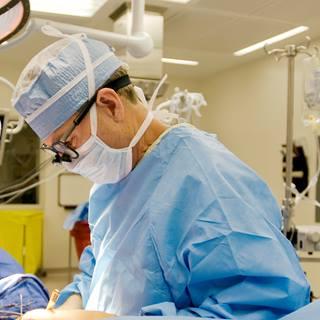主动脉 狭窄

Overview
The aorta is the main artery that carries oxygen-rich blood from the heart to the rest of your body. 当你的心脏和主动脉之间的瓣膜变窄时, 这种情况被称为主动脉瓣狭窄.
因为狭窄的开口限制了血液流动, your heart has to work harder to pump blood through the aorta and meet your body's needs. 起初,这可能不会引起任何症状. 随着病情的发展,瓣膜变窄, 你可能会感到胸痛, 呼吸急促(气促), 头晕或昏厥. 随着时间的推移,这种压力会削弱你的心脏,并导致 心脏衰竭. 严重的主动脉狭窄是不可预防的,但可以治疗.
主动脉狭窄的治疗方法
加州大学旧金山分校是国际公认的心脏护理. 我们的心脏瓣膜病诊所 brings together interventional cardiologists and cardiothoracic surgeons to provide comprehensive care for patients with aortic valve stenosis. 我们的专家提供全方位的治疗, 从微创手术到开胸手术. 此外, 我们的十大赌博平台排行榜积极从事研究工作, meaning our patients have access to the latest therapies and opportunities to take part in clinical trials (studies of promising new treatments).
奖 & 识别
-

是全国顶尖的十大赌博平台排行榜之一
-

全国最好的心脏病和心脏专家之一 & 血管手术
原因 & 症状
原因
主动脉 stenosis is the most common form of valve disease, occurring more often in men than women. 对大多数人来说,这种情况会随着年龄的增长而发展. 2人以上.5 million people over the age of 75 in the United States have aortic stenosis.
严重的主动脉狭窄可能与以下因素有关:
- 衰老是一个因素. Age-related aortic stenosis usually begins after age 60 as a result of calcium buildup in the valve, 但症状通常要到70岁甚至80岁才会出现.
- 放射治疗, 哪些是用来治疗某些癌症的, 会引起瓣膜增厚和钙化吗.
- A bacterial infection that causes scar tissue to form in the heart (as may occur with rheumatic fever) can prevent the valve from working normally.
- High cholesterol increases fat deposits, which can narrow the valve opening.
- A birth defect can affect the valve's structure and how well it functions.
症状
在主动脉狭窄的轻到中度阶段, 血流通常没有限制到足以引起症状. 许多人不知道他们在这个阶段有这种情况. Some patients are told that they have a heart murmur during a routine checkup.
As the condition progresses, the opening narrows further and the heart muscle weakens. 当主动脉狭窄变得严重, 患者注意到不舒服的症状, 比如呼吸急促或疲劳. 这可能会危及生命, so it's crucial to tell your doctor right away if you notice new 症状 or your 症状 worsen.
诊断
We use several tests to diagnose aortic stenosis and assess its severity.
超声心动图
An 超声心动图 是心脏的超声波吗. 它能产生心室的图像, 瓣膜和血流, and can also show whether blood is clotting inside the pumping heart. 我们做了经食管超声心动图(TEE), in which a long flexible tube conveys a transducer (device emitting sound waves) down the throat. A TEE provides clearer images than those obtained from outside the body.
血管造影
An 血管造影 是另一种成像测试吗. 考试期间, 十大赌博平台排行榜插入了一根薄片, flexible tube called a catheter into a blood vessel (usually in the groin area) and threads it up to the heart. The doctor then injects a harmless dye that shows up well on X-rays through the catheter to track the flow of blood to the heart.
胸部x光片
A 胸部x光片 reveals the presence of calcium deposits and shows the size and shape of the heart and lungs. All patients who need heart valve surgery have a 胸部x光片 beforehand.
治疗
监测你的状况, the American College of Cardiology and American 心 Association recommend having an 超声心动图 every three to five years if you have mild aortic stenosis and every one to two years if you have moderate aortic stenosis.
你的治疗取决于你病情的严重程度. If the stenosis is mild or moderate, you may not have 症状 or need treatment. 一定要告诉你的十大赌博平台排行榜任何新的或恶化的症状.
As the disease progresses, you may need to have the damaged valve replaced. 有几种方法可以做到这一点.
开胸手术
在心脏直视手术中, the surgeon makes an incision in the middle of the chest to reach and remove the damaged valve and place a new one. The new valve may be made from animal tissue or a durable material, such as titanium. 或者,在开胸手术中 罗斯过程, one of the patient's own functional heart valves is used as the replacement. Because the heart's beating must be paused for these types of procedures, 手术过程中,病人需要借助心肺搭桥机. Some patients aren't candidates for open-heart surgery because they are too ill or have other conditions that make it too risky. The 罗斯过程 is generally only for patients under the age of 60.
微创瓣膜置换术
就像开胸手术一样, the patient must be on a heart-lung bypass machine during a minimally invasive valve replacement. 然而, the surgeon is able to perform the procedure via a much smaller incision in the chest, using a tiny camera and slender tools to remove and replace the damaged valve. This is an option for some patients who can't have traditional open-heart surgery.
经导管主动脉瓣置换术
TAVR is an even less invasive procedure we can offer to some patients, based on their evaluation. 而不是在胸部开个切口, the surgeon threads a catheter through a blood vessel to reach the heart, 然后在旧的阀门里面插入一个新的阀门. TAVR是在心脏跳动时进行的, 所以病人不需要使用心肺搭桥机.
球囊主动脉瓣成形术
This minimally invasive procedure aims to widen the narrowed valve rather than replace it. A catheter with a tiny deflated balloon at its tip is threaded through a blood vessel until it reaches the damaged valve. At that point, the balloon is inflated to expand the narrowed valve. 然后将球囊放气,取出导管.
加州大学旧金山分校健康医学专家已经审查了这些信息. It is for educational purposes only and is not intended to replace the advice of your doctor or other health care provider. We encourage you to discuss any questions or concerns you may have with your provider.











